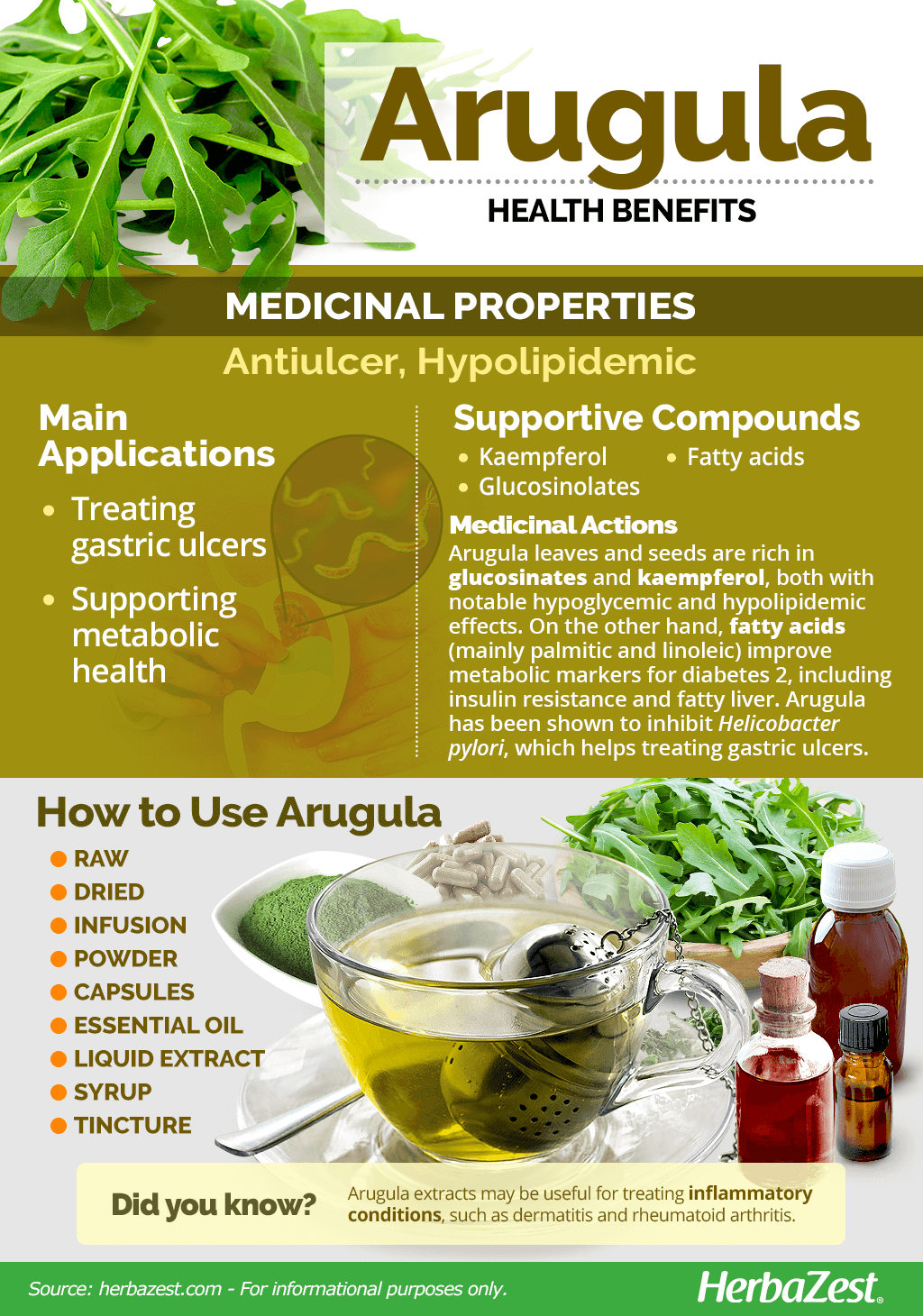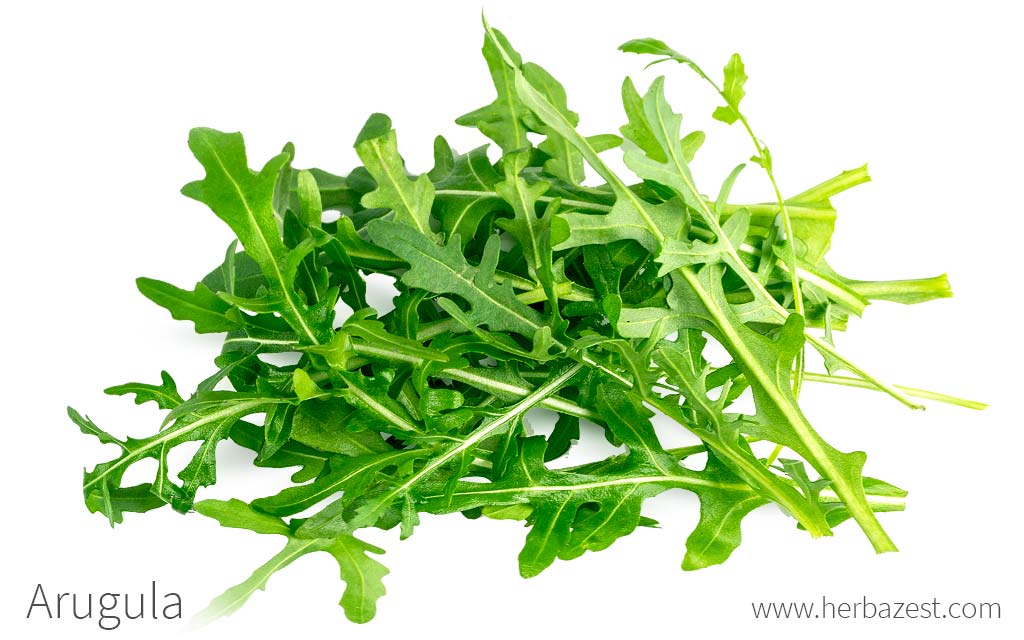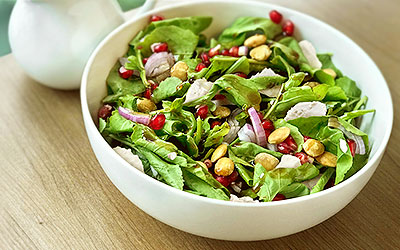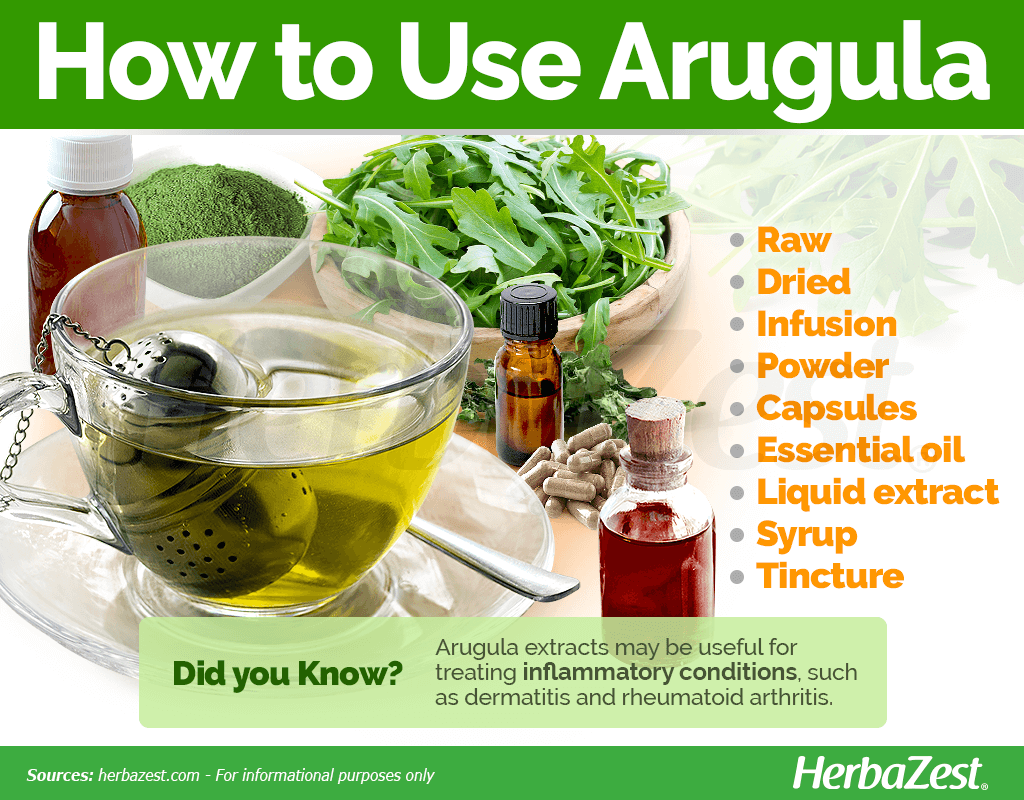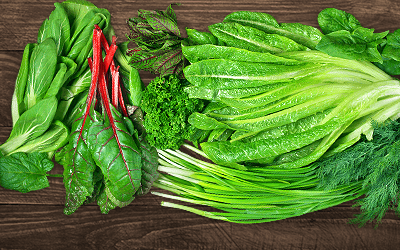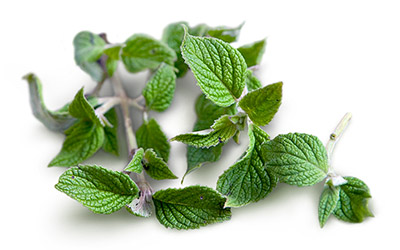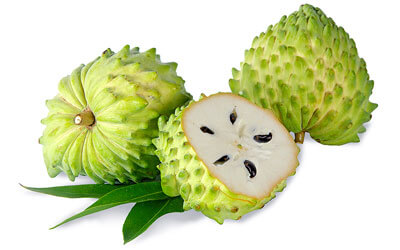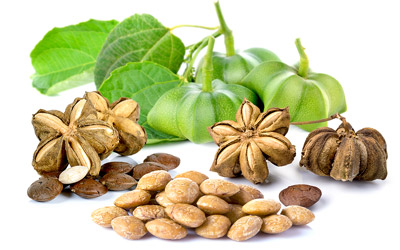Hailing from the Mediterranean region, arugula, also known as garden rocket, roquette, and rucula, among other names, has been used for centuries in culinary and medicinal contexts. Arugula is highly valued in both Ayurveda and Traditional Chinese Medicine (TCM) as a bitter tonic, primarily prescribed for liver and skin disorders.
Arugula Medicinal Properties
- Medicinal action Antiulcer, Hypolipidemic
- Key constituents Kaempferol, glucosinolates, fatty acids
- Ways to use Capsules, Hot infusions/tisanes, Liquid extracts, Food, Tincture, Powder, Syrup, Essential oil, Dried
- Medicinal rating (3) Reasonably useful plant
- Safety ranking Safe
Health Benefits of Arugula
Arugula leaves and seeds have a long history of therapeutic uses in Ayurvedic and Chinese traditional medicine, particularly for gastrointestinal and liver-related issues. Modern research has corroborated some of these ancient applications. According to scientific data, the main benefits of arugula include:
Treating gastric ulcers. Arugula's anti-inflammatory and antimicrobial properties have proven effective in healing gastric ulcers.
Supporting metabolic health. Arugula may help improve metabolic markers, including body mass index (BMI), total cholesterol, blood sugar levels, and blood pressure.
ARUGULA'S ANTIOXIDANT PROPERTIES PROMOTE THE ELIMINATION OF LIVER TOXINS AND HELP IMPROVE INSULIN RESISTANCE.
Additional benefits of arugula include:
Treating infections. Thanks to its antimicrobial compounds, arugula has been shown to combat bacterial strains. Traditionally, it has been used to treat urinary and skin infections, fever, and diarrhea.
Protecting kidney health. The diuretic and antioxidant properties of arugula have made it a popular remedy for kidney infections and kidney stones.
Other potential benefits explored in scientific research include improving male fertility, alleviating rheumatoid arthritis, and reducing edema.
How It Works
Arugula leaves and seeds are rich in medicinal compounds, mainly kaempferol and glucosinolates. Other key compounds in the plant's aerial parts include fatty acids (mainly palmitic and linoleic acids), alkaloids, terpenoids, saponins, and sterols.
Glucosinolates not only contribute to arugula's distinct peppery taste but also exhibit powerful antioxidant activity. These compounds are involved in various biological processes, including inflammation and infection, and have notable hypoglycemic and hypolipidemic effects when combined with other phenolics.1
Due to its antimicrobial and anti-inflammatory properties, arugula has been shown to reduce urease activity, an enzyme used by Helicobacter pylori to colonize the stomach lining, thus aiding in the treatment of gastric ulcers.2,3
Leaf extracts rich in fatty-acids have demonstrated effectiveness in improving metabolic markers in type 2 diabetes, including insulin resistance and fat accumulation in the liver.4
ARUGULA EXTRACTS MAY BE USEFUL FOR TREATING INFLAMMATORY CONDITIONS, SUCH AS DERMATITIS AND RHEUMATOID ARTHRITIS.5,6
Other bitter herbs with hepatoprotective and antidiabetic properties include dandelion, chicory, and hepatica.
Side Effects & Cautions
Arugula is generally safe for culinary use. However, due to its high fiber content, excessive consumption may lead to bloating, gas, indigestion, or diarrhea. Like other leafy greens, arugula contains oxalates, which can promote kidney stone formation and should be avoided by individuals with kidney conditions.
Arugula is also rich in vitamin K, a blood-clotting nutrient. Those with blood disorders or on blood-thinning medications should consume it in moderation and consult a healthcare professional before using it medicinally. Additionally, some individuals may experience allergic reactions.
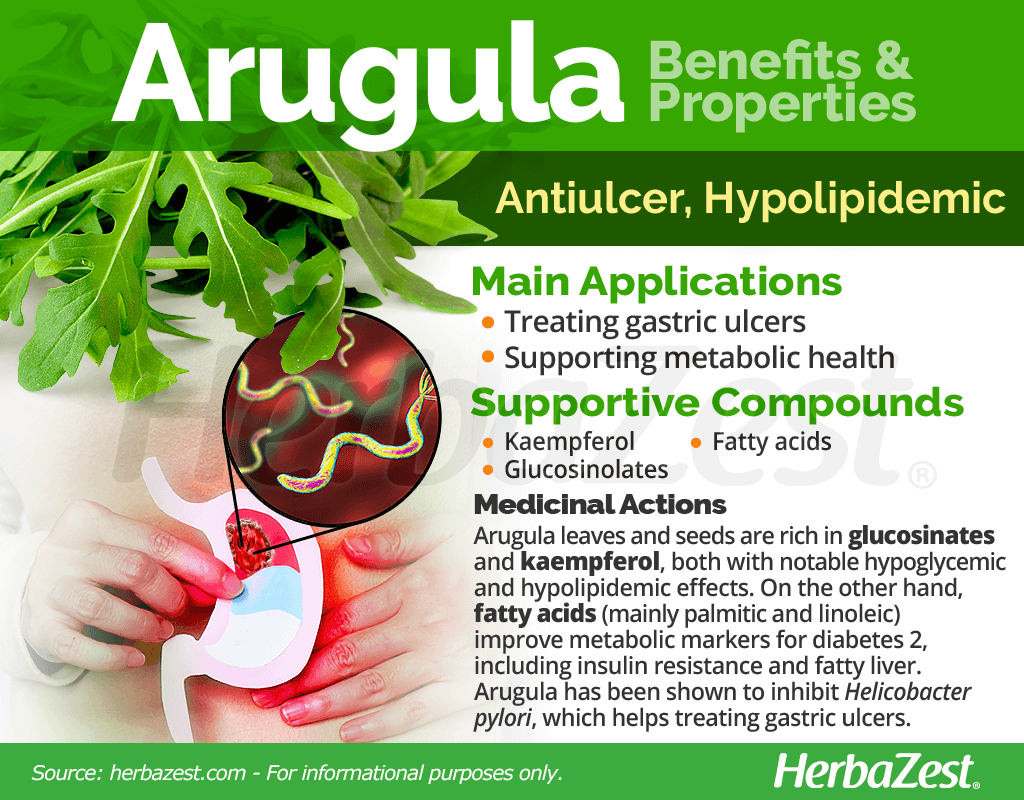
Arugula Nutrition
Arugula is a nutrient-dense leafy green that offers plant-based protein and dietary fiber while being low in calories, making it an excellent addition to a healthy diet.
Arugula leaves provide good amounts of calcium, which is essential for strong bones and teeth; magnesium, needed for muscle function, blood sugar control, and blood pressure regulation; and manganese, important for metabolism, reproductive function, and immunity. Arugula also offers adequate levels of other important minerals, such as iron, which supports red blood cell production; potassium, vital for kidney, heart, and muscle function; and copper, essential for energy production, nervous system health, and connective tissue repair.
The most abundant vitamin in arugula is vitamin K (phylloquinone), which supports blood clotting and bone health. Arugula is also a rich source of vitamin C (ascorbic acid), which protects against oxidative damage and improves iron absorption; and folate (vitamin B9), critical for fetal development and cell division; pro-vitamin A (from carotenoids like lutein), important for vision and skin health; and vitamins B2 (riboflavin) and B5 (pantothenic acid), both necessary for energy metabolism.
100 GRAMS OF FRESH ARUGULA LEAVES PROVIDE 25 CALORIES, 5% DV OF PLANT-BASED PROTEIN, AND 6% DV OF DIETARY FIBER.
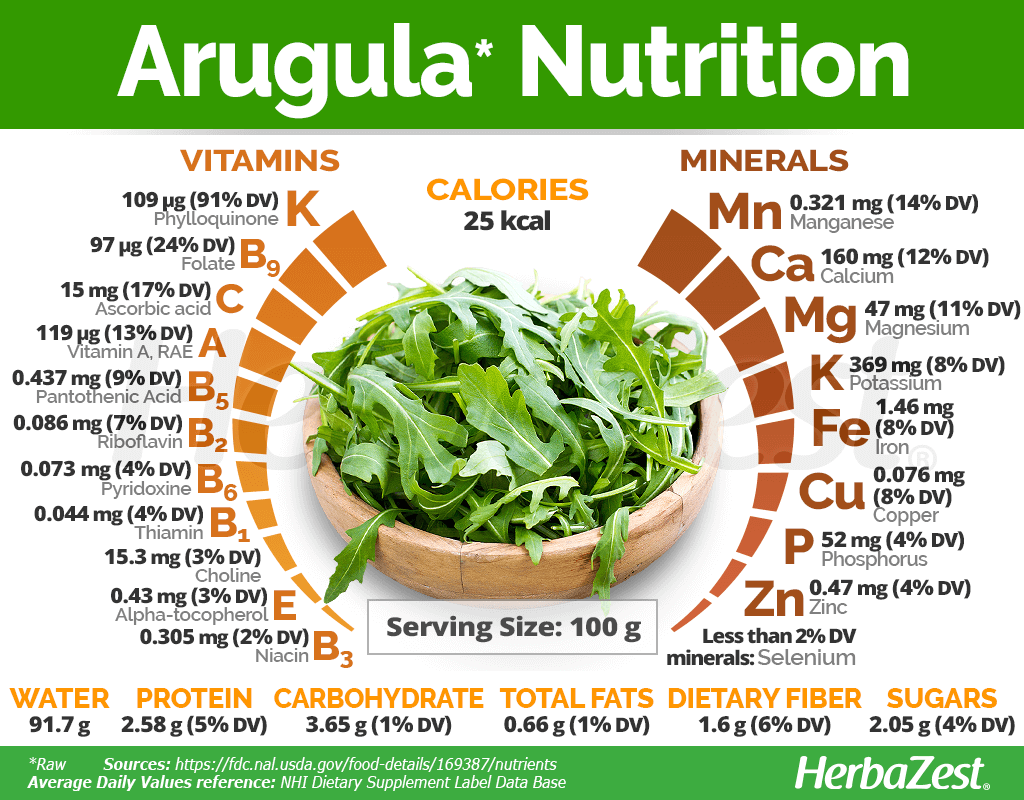
How to Consume Arugula
- Edible parts Flowers, Leaves, Seed, Seedpod
- Edible uses Condiment
- Taste Bitter
With a bitter, peppery flavor, arugula leaves are commonly used fresh in culinary recipes, such as salads, but also as a condiment to spice up many dishes. However, arugula has also been traditionally consumed in medicinal preparations as a complementary treatment for various health conditions.
Natural Forms
Raw. Fresh arugula leaves are a popular ingredient in salads, often combined with other leafy greens that enhance their properties and somehow reduce their bitter taste.
Dried. Dried arugula leaves bring a peppery taste to some dishes, also contributing with their anti-inflammatory and antidiabetic benefits.
Infusion. A warm or cold infusion of arugula leaves and seeds can be an easy way to reap the hypoglycemic and hypolipidemic effects of this herb, as well as its antiulcer properties.
Powder. Arugula's dried and powdered leaves can be used as a condiment to season culinary recipes or as an ingredient in homemade medicines.
Herbal Remedies & Supplements
Capsules. The antiulcer and metabolic benefits of arugula can be obtained from capsules, which may contain the herb's essential oil or powdered leaves.
Essential oil. Arugula oil is rich in natural compounds that promote skin health and help reduce blood sugar levels.
Liquid extract. In this form, arugula is thought to be helpful for the topical treatment of skin problems, such as eczema and psoriasis, while also protecting the skin from oxidative damage.
Syrup. The antiulcer, antidiabetic, and anti-inflammatory properties of arugula can be obtained in syrup form, with the added advantage of masking its bitter flavor.
Tincture. Arugula tincture is a concentrated form that should be diluted in water to obtain its benefits.
Growing
- Life cycle Annual
- Harvested parts Flowers, Seeds, Leaves
- Light requirements Full sun
- Soil Well-drained
- Soil pH 6.1 – 6.5 (Slightly acidic), 6.6 – 7.3 (Neutral)
- Growing habitat Cool temperate regions
- USDA Plant Hardiness Zones 2a, 2b, 3a, 3b, 4a, 4b, 5a, 5b, 6a, 6b, 7a, 7b, 8a, 8b, 9a, 9b, 10a, 10b, 11a, 11b
- Pre-germination seed treatment None
- Planting time Early spring, Fall
- Plant spacing average 0.15 m (0.49 ft)
- Growing time 35-50 days
- Potential insect pests Aphids, Caterpillars, Flea beetles
- Potential diseases Root rot, Bacterial leaf spot, Downy mildew
Arugula, also known as garden rocket, roquette, and rucula, among other names, is ideal for gardens located in cool, temperate climates. With some basic care, this nutritious leafy green can provide fresh sustenance for most of the year.
Growing Guidelines
Arugula can be grown in a wide range of soils; however, it prefers fertile loamy or muck soils, with good drainage system and a pH of 6.0-7.0. If planting in a field, the area must be plowed several times to promote germination.
Arugula plants are grown from seeds, which are directly planted 1/4 to ½ inch (0.6 - 1.3 cm) deep, with 2 inches (5 cm) between plants in a row. Rows should be spaced 12-15 inches (31-38 cm) apart. It is recommended to stagger plantings once or twice per week to ensure a constant supply.
To thrive, arugula plants require 4-6 hours of full sun or light shade and prefer temperatures between 50-65°F (10-18°C). In temperate areas, arugula is planted in early spring or late fall since it can withstand light frost. Depending on the cultivar and conditions, arugula will be ready to harvest within 35-50 days.
For optimal development, arugula plants need a steady water supply; however, excessive irrigation must be avoided. It is recommended to water the plants only when the top inch of soil feels dry to the touch.
Arugula plants can be attacked by aphids, caterpillars, and flea beetles. Common diseases, usually caused by excessive moisture, include downy mildew, root rot, and bacterial leaf spot.
Additional Information
- Other uses Animal feed, Soapmaking
Plant Biology
Arugula, also known as garden rocket, rocket, roquette, and rucula, is an annual plant grown similarly to other leafy greens. Arugula plants can reach 10-24 inches (25-61 cm) in height, with irregular, pinnately lobed basal leaves that grow in rosettes. Each leaf typically has 4 to 10 small lateral lobes and a large terminal lobe. The upper stem leaves are entire and smaller. Four-petalled flowers, about 1 inch (2.5 cm) long, bloom in clusters, with proportionally longer lower stalks that form a flat or slightly convex head. Each flower has a pale-yellow corolla, yellow stamens, and dark brown or purple veins. Arugula's beaked pods or fruits are up to 1.5 inches (4 cm) long and contain about 10 seeds, which are spherical or ovoid and measure about 0.1 inches (1.5-2 mm) in diameter, pale brown to olive green.
Classification
Arugula (Eruca sativa) belongs to the Brassicaceae or mustard family, which also includes cruciferous vegetables such as cabbage (Brassica oleracea var. capitata), Brussels sprouts (Brassica oleracea var. gemmifera), broccoli (Brassica oleracea), radish (Raphanus sativus), and mustard (Brassica spp.), as well as other species with notable medicinal benefits like maca (Lepidium meyenii), nasturtium (Tropaeolum majus), and woad (Isatis tinctoria).
Varieties of arugula
The genus Eruca consists of a single species, Eruca vesicaria (L.), with three known subspecies: subsp. sativa, subsp. vesicaria, and subsp. pinnatifida. Eruca vesicaria subsp. sativa is commonly referred to by its simplified synonym E. sativa.
Another leafy green that is often confused with arugula is wild arugula, also known as wild rocket and perennial wall-rocket (Diplotaxis tenuifolia), which shares a similar taste and culinary uses with Eruca sativa.
Historical Information
Arugula has been a staple in Mediterranean, African, Middle Eastern, and Asian diets for centuries. This peppery-flavored leafy green was mentioned by Dioscorides in the first century and is also referenced in the Talmud and the Old Testament of the Bible as "oroth" (2 Kings 4:39).
Economic Data
This cruciferous vegetable is widely cultivated across the Mediterranean region, including Italy, Spain, Tunisia, Algeria, and Morocco, as well as other parts of the world such as France, Germany, the UK, the USA, India, and Australia. The world's largest producer of arugula is currently India. In Europe, the main producers are Spain, Italy, France, Germany, the Netherlands, and Belgium. Most arugula in the USA is grown in California and Arizona.
Other Uses
Industrial. Arugula seeds are used to produce cooking and industrial oil, especially for soap and lubricant manufacturing.
Fodder. Arugula leaves and seeds are also used as animal feed.
Sources
- Asian Journal of Pharmaceutical and Clinical Research, ERUCA SATIVA LINN.: PHARMACOGNOSTICAL AND PHARMACOLOGICAL PROPERTIES AND PHARMACEUTICAL PREPARATIONS, 2019
- Cellmed, THE THERAPEUTIC USES AND PHARMACOPEAL ACTION OF JIRJEER (Eruca sativa): A Review, 2022
- Current Advances for Development of Functional Foods Modulating Inflammation and Oxidative Stress, Arugula, 2022
- FoodData Central, Arugula, raw, 2019
- Healthy South Dakota, January Veggie of the Month: Arugula n/d
- Missouri Botanical Garden, Eruca vesicaria subsp. sativa n/d
- Nutrients, Emerging Role of Eruca sativa Mill. in Male Reproductive Health, 2024
- Oregon State University, Arugula, Eruca vesicaria ssp. sativa, 2010
- Towne's Harvest Garden, Arugula n/d
- University of Arizona, Crop Profile for Arugula in Arizona, n/d
- University of Delaware, Agriculture & Natural Resources, Arugula, 2024
- University of Florida, Arugula: Planting and Care n/d
- Wild Crop Relatives: Genomic and Breeding Resources: Vegetables, Eruca, pp.149-160
Footnotes
- Pharmacognosy Magazine. (2017). Contribution of the Glucosinolate Fraction to the Overall Antioxidant Potential, Cytoprotection against Oxidative Insult and Antimicrobial Activity of Eruca sativa Mill. Leaves Extract. Retrieved March 10, 2025, from: https://pmc.ncbi.nlm.nih.gov/articles/PMC5701420/
- Journal of Evidence-Based Complementary & Alternative Medicine. (2014). Antiulcer Effect of Extract/Fractions of Eruca sativa: Attenuation of Urease Activity. Retrieved March 11, 2025, from: https://pubmed.ncbi.nlm.nih.gov/24647097/
- World Journal of Gastroenterology. (2009). Rocket “Eruca sativa”: A salad herb with potential gastric anti-ulcer activity. Retrieved March 10, 2025, from: https://pmc.ncbi.nlm.nih.gov/articles/PMC2675085/
- Pharmaceutical Biology. (2017). The fatty acid-rich fraction of Eruca sativa (rocket salad) leaf extract exerts antidiabetic effects in cultured skeletal muscle, adipocytes and liver cells. Retrieved March 11, 2025, from: https://pmc.ncbi.nlm.nih.gov/articles/PMC6130626/
- Phytotherapy Research. (2014). Eruca sativa and its Flavonoid Components, Quercetin and Isorhamnetin, Improve Skin Barrier Function by Activation of Peroxisome Proliferator-Activated Receptor (PPAR)-α and Suppression of Inflammatory Cytokines. Retrieved March 10, 2025, from: https://onlinelibrary.wiley.com/doi/abs/10.1002/ptr.5138
- Pakistan Journal of Pharmaceutical Sciences. (2021). Ethyl-acetate extract of tara mira (Eruca sativa) alleviates the inflammation and rheumatoid arthritis in rats. Retrieved March 11, 2025, from: https://pubmed.ncbi.nlm.nih.gov/34836857/
